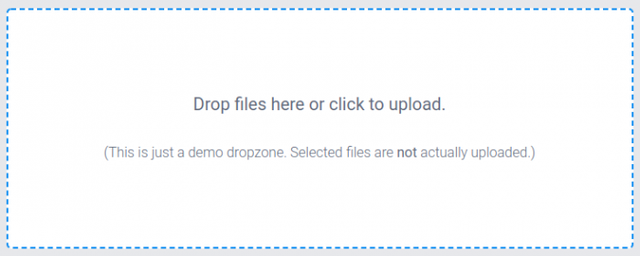Dropzonejs를 이용해 Drag & Drop 파일 업로드 기능을 구현했다. form 페이지에서 업로드 이미지를 추가하고 submit 버튼을 클릭했을 때 서버로 이미지 파일이 업로드되도록 했고 추가된 이미지 파일을 삭제했을 때 서버에 저장된 이미지도 삭제되도록 기능을 구현했다. 스크립트 코드 중 일부는 jQuery를 이용하기 때문에 함께 로드되어야 한다.
<form name="fname">
<label for="fld">필드</label>
<input type="text" name="fld" id="fld" value="">
<div class="dropzone" id="fileDropzone"></div>
</form>
form은 위와 같이 추가적인 input 필드와 dropzone이 포함되어 있다. Dropzonejs 사용을 위해 스크립트 파일을 로드한다.
<script src="./js/dropzone.js"></script>
Dropzonejs 실행을 위한 설정 등은 아래의 코드로 한다. 업로드 파일은 최대 2개, 이미지 파일만 업로드 하도록 설정했다. 서버의 파일도 삭제하기 위해 removefile 을 새로 설정했다. 업로드 이미지 파일이 없을 때도 form submit을 위해 getQueuedFiles() 를 이용해 처리했다.
<script>
Dropzone.options.fileDropzone = {
url: './fileUpload.php',
autoProcessQueue: false,
uploadMultiple: true,
parallelUploads: 2,
maxFiles: 2,
maxFilesize: 1,
acceptedFiles: 'image/*',
addRemoveLinks: true,
removedfile: function(file) {
var srvFile = $(file._removeLink).data("srvFile");
$.ajax({
type: 'POST',
async: false,
cache: false,
url: './fileDelete.php',
data: { file: srvFile }
});
var _ref;
(_ref = file.previewElement) != null ? _ref.parentNode.removeChild(file.previewElement) : void 0;
setFilesName();
return;
},
init: function() {
var fileDropzone = this;
// Uploaded images
// First change the button to actually tell Dropzone to process the queue.
document.querySelector("button[type=submit]").addEventListener("click", function(e) {
// Make sure that the form isn't actually being sent.
e.preventDefault();
e.stopPropagation();
// Form check
if(checkForm()) {
if (fileDropzone.getQueuedFiles().length > 0) {
fileDropzone.processQueue();
} else {
setFilesName();
submitForm();
}
}
});
// Append all the additional input data of your form here!
this.on("sending", function(file, xhr, formData) {
formData.append("token", $("input[name=token]").val());
});
// Listen to the sendingmultiple event. In this case, it's the sendingmultiple event instead
// of the sending event because uploadMultiple is set to true.
this.on("sendingmultiple", function() {
// Gets triggered when the form is actually being sent.
// Hide the success button or the complete form.
});
this.on("successmultiple", function(files, response) {
// Gets triggered when the files have successfully been sent.
// Redirect user or notify of success.
var obj = JSON.parse(response);
for(i=0; i<files.length; i++) {
$(files[i]._removeLink).data('srvFile', obj[files[i].name]);
}
setFilesName();
// form submit
submitForm();
});
this.on("errormultiple", function(files, response) {
// Gets triggered when there was an error sending the files.
// Maybe show form again, and notify user of error
});
}
};
</script>
서버 업로드 파일 처리를 위한 Class는 아래와 같다.
<?php
/**
* File Upload class
*/
class FILEUPLOAD
{
protected $dest;
protected $ext;
protected $chunkTime;
public function __construct()
{
if(!is_writable(FILES_PATH))
throw new \Exception('Unable to write');
$dest = FILES_PATH.DIRECTORY_SEPARATOR.'tmp';
if(!is_dir($dest)) {
mkdir($dest, 0755);
chmod($dest, 0755);
}
$this->dest = $dest;
$this->ext = array( 1 => 'gif', 2 => 'jpg', 3 => 'png');
$this->chunkTime = 86400 * 2;
}
public function fileName()
{
list($usec) = explode(' ', microtime());
$usec = preg_replace('#[^0-9]#', '', $usec);
return md5(date('YmdHis', time()).$usec);
}
public function chunkDelete()
{
foreach (scandir($this->dest) as $c) {
if ($c == '.' || $c == '..')
continue;
$f = $this->dest . DIRECTORY_SEPARATOR . $c;
if (is_dir($f))
rmdir($f);
if (time() - filemtime($f) > $this->chunkTime)
unlink($f);
}
}
public function upload()
{
$result = array();
// chunk delete
$this->chunkDelete();
$cnt = count($_FILES['file']['name']);
for ($i = 0; $i < $cnt; $i++) {
$file = $_FILES['file']['tmp_name'][$i];
if ($file) {
$size = getimagesize($file);
if ($size[2] >= 1 && $size[2] <= 3) {
while (1) {
$name = $this->fileName();
$dest = $this->dest.DIRECTORY_SEPARATOR.$name.'.'.$this->ext[$size[2]];
if(is_file($dest)) {
usleep(10);
continue;
}
break;
}
move_uploaded_file($file, $dest);
$result[$_FILES['file']['name'][$i]] = str_replace(NT_FILES_PATH, '', $dest);
}
}
}
return $result;
}
}
업로드 파일 처리를 위한 fileUpload.php 파일은 아래와 같다.
<?php
define('FILES_PATH', __DIR__.'/files');
$result = array();
if (!empty($_FILES)) {
$file = new FILEUPLOAD();
$result = $file->upload();
}
die(json_encode($result));
업로드 파일 삭제를 위한 fileDelete.php 파일은 아래와 같다.
<?php
define('FILES_PATH', __DIR__.'/files');
$file = $_POST['file'];
if ($file) {
$path = FILES_PATH.$file;
if (is_file($path))
unlink($path);
}
파일 삭제의 경우 파일명만 알면 삭제가 되기 때문에 추가적인 보안조치가 있어야 한다.
추가 내용으로 서버에 업로드된 파일의 썸네일을 Dropzone 에 표시되게 하려면 아래와 같은 코드가 Dropzonjs 설정 스크립트 코드 중 // Uploaded images 다음에 추가하면 된다.
var mockFile;
var fileCount = 0;
$.getJSON("./getFiles.php", function(data) {
$.each(data, function(key, value) {
mockFile = { name: value.name, size: value.size };
fileDropzone.emit("addedfile", mockFile);
fileDropzone.emit("thumbnail", mockFile, value.data);
fileDropzone.emit("complete", mockFile);
$(mockFile._removeLink).data("srvFile", value.path);
fileCount++;
});
fileDropzone.options.maxFiles = fileDropzone.options.maxFiles - fileCount;
});
getFiles.php 파일의 아래와 같다.
<?php
define('FILES_PATH', __DIR__.'/files);
$files = array();
for($i = 1; $i <= 2; $i++) {
if ($row['file'.$i]) {
$file = FILES_PATH.$row['file'.$i];
if (is_file($file)) {
$size = filesize($file);
$name = basename($file);
$path = str_replace(FILES_PATH, '', $file);
$mime = mime_content_type($file);
$data = 'data:'.$mime.';base64,'.base64_encode(file_get_contents($file));
$files[] = array(
'name' => $name,
'size' => $size,
'path' => $path,
'data' => $data
);
}
}
}
die(json_encode($files));
서버에 업로드된 이미지의 사이즈가 큰 경우 썸네일이 정상적으로 표시되지 않을 수 있는데 이 때는 css 코드를 이용해 썸네일 사이즈를 지정해준다.
.dz-image img {width: 120px; height: 120px}
